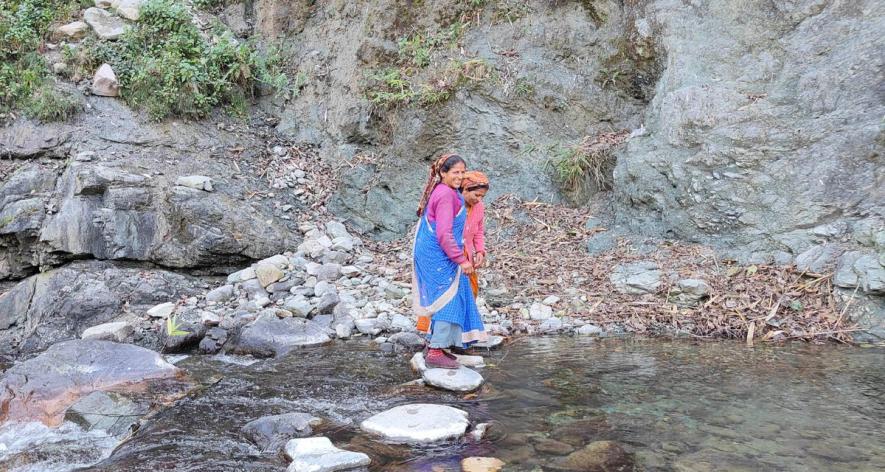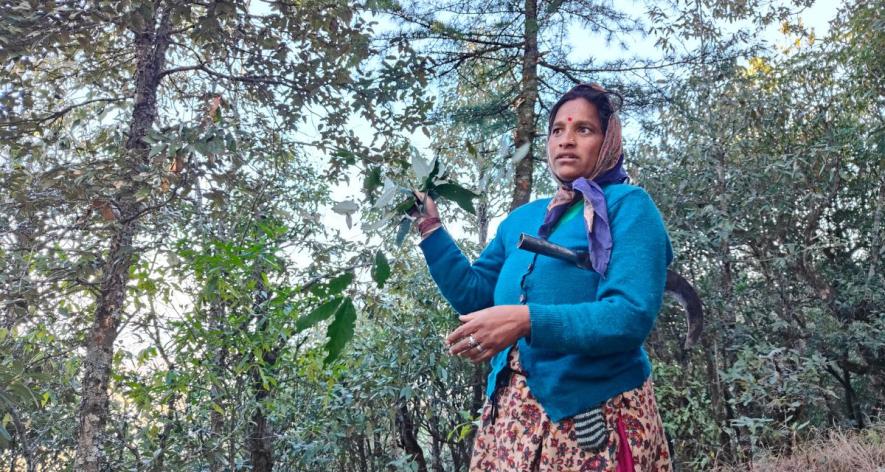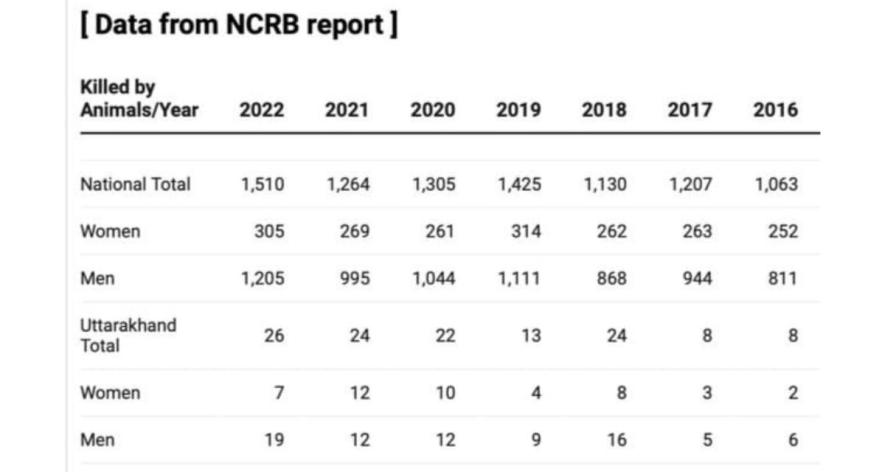Tiger Burning Bright in Forests of Uttarakhand, but Women Cannot Wait or Shirk Duty

Women crossing a river in the forest (Photo - Varsha Singh, 101Reporters)
Nainital, Uttarakhand: Around 4 pm on December 19, the women cutting grass in the forest came down screaming. “A tiger dragged away Nikita,” they hollered. About half a km from his home, a village girl informed Vipinchand Sharma (52) that his daughter Nikita Sharma (22) had fallen prey. A stunned Sharma and his wife nervously ran towards the forest.
“I grabbed her lifeless body from the bushes and carried her in my arms,” says a grief-stricken Vipinchand.
The fields of Alchaunaa in Bhimtal block of Nainital district border the village forest. Like other rural women, Nikita used to bring wood and fodder for livestock from the forest to meet the needs of the house. Her death was the third such case of attack on a woman within 10 days. In all three cases, women had ventured into the forest to collect grass, leaves and wood.
“Tiger attacks are more common than before and women are increasingly becoming their victims. Both the lives and livelihood of women depend on forests. Whether we want to get wood for cooking or fodder for animals, we have to go to the forest. We also add leaves collected from the forest to the cow dung to prepare a fertiliser. If women do not go to the forest, how will they raise their animals or do farming,” asks Hema Joshi, a social activist working on women's issues in Bhimtal block, who took part in the protests that rural women organised following Nikita's death.
“Had there been good rainfall in winter, the trees would have been green at this point, and we would have got good grass for fodder. This year, there was no rain at all in winter. Both fields and forests are dry, so women have to venture deeper into the forests. There is always a fear of attack by wild animals there,” Joshi adds.
According to local media reports, at least eight women were mauled to death last year in the forest or the fields adjacent to the forest. This January and February, at least four women became victims of tiger attacks. Last year, at least five women in Uttarakhand lost their lives to leopard attacks as well.
According to the Uttarakhand forest department, 71, 82 and 66 deaths due to wild animal attacks were recorded in 2021, 2022 and 2023, respectively. Of these, two deaths in 2021, 16 in 2022 and 17 in 2023 were due to tiger attacks. However, the department has not released gender-specific figures. Asked about this, Uttarakhand Chief Wildlife Warden Samir Sinha tells 101Reporters that in future, they will analyse the deaths and injuries in human-wildlife conflict based on gender.
Climate of conflict
Mapping of climate change hotspots in Indian forests report of the Forest Survey of India identifies Uttarakhand as a ‘high category’ climate hotspot, where serious effects of climate change can be noticed. There has been very little rainfall and snowfall in the Himalayan states last December. Uttarakhand received 75% less rain than normal then, and faced drought conditions this January.
Rain in February brought some relief, but according to the Indian Meteorological Department, between January 1 and February 29, Uttarakhand witnessed a record rainfall deficit of 52%. The temperatures in February were reminiscent of March, while the heat conditions in March felt like that in April.
“Climate change is exacerbating an already disturbed system,” Suruchi Bhadwal, Earth Science and Climate Change Director at The Energy and Resources Institute, tells 101Reporters. “Forests, wildlife and rural areas are all under pressure. Due to the socio-economic conditions in Uttarakhand, only women go to the forests for wood and fodder, hence both the burden of labour and climate threat are more on them. That is why women are also victims of human-wildlife conflict,” says Bhadwal.
After Nikita was mauled to death, the forest department has prohibited Alchaunaa residents from venturing into the forest and has promised to arrange fodder. “The dairy to which we supply milk provided us fodder for just one month and deducted the price of the fodder from the money they owe us. We thought the forest department had sent the fodder as promised, but that was not the case. The fodder we got was provided by the dairy itself. We cannot raise animals by purchasing fodder,” says Vipinchand.

A woman plucking leaves in the forest of Nainital (Photo - Varsha Singh, 101Reporters)
While noting that work has to be done to improve the livelihood of the hill residents, PK Patro, Chief Forest Conservator, Kumaon, asks, “When you know such incidents are happening in the forest, why are you going inside.” “Caution in and around the forest is the only way out. Women go in groups from the village, but get separated inside the forest,” he adds.
“Both our needs and employment are related to the forest,” says Leela Bhatt (54) of Alchaunaa. “I rear cows and calves, so I have to go to the forest for them. We also have to go to the forest for fuel. The weather here is cold and water has to be heated even for cows and calves.”
“We do not earn enough to buy and use gas cylinders every month. We also have to go to the forest to make fertiliser for the fields. This is how our house runs,” says Leela, whose family earns up to Rs 10,000 a month by selling vegetables and milk.
Patro says that the forest department is working to prepare an early warning system by installing Artificial Intelligence-based cameras, which will help send SMSes to people about the movement of wild animals. He suggests that the dependency on the forest should be reduced by making available the Pradhan Mantri Ujjwala Yojana and fodder schemes of the animal husbandry department.
Amidst the increasing threat of tiger, now one or two men from the village also accompany the group of women entering the forest. But they are concerned as well. "If the men in the village do the work related to the forest, then who will work in the fields? Who will take the vegetables grown in the fields to the market," asks Vipinchand, whose work is to transport goods on a horse. He says men also go to the forest when needed, "but in everyday life, all these tasks have to be done by women only".
Gopal Lodhiyal, a farmer and gardener from Lodhgalla village in Ramgarh development block of Nainital, says that while women traditionally take care of the house and the forest, men are busy with responsibilities of the fields and jobs to earn their livelihood. "Some work as labourers, some run shops. Men from many families have migrated to Haldwani, Delhi or other cities for jobs. In their absence, women handle most of the household responsibilities."
The call of duty paramount, women are shirking away fear to bring wood and fodder home. “I myself saw a tiger up close. The forest department has caught the tiger that killed Nikita, but we still hear the growls. We are afraid of tigers even when we are in the fields or near the water sources,” says Hema Bhatt (34) of Alchaunaa.
The fearful symmetry
In Uttarakhand, the forests adjacent to residential areas are a common space for both wildlife and humans. Around 85% of the state's land is mountainous. In 10 out of the 13 hill districts of the state, over 75% of the population lives in rural areas and depends on farming. According to a report from the State Migration Prevention Commission, the per capita income of the rural population is low due to a decline in production and farming area. Low income increases the rural community's dependence on natural resources.
At the same time, due to conservation efforts in the country, the tiger population increased from 2,967 in 2018 to a minimum of 3,167 in 2022. Among the Himalayan states, the plains of Uttarakhand, especially the Corbett, are the richest habitats of tigers.
Tiger population in Uttarakhand increased by 314% between 2006 and 2022. The state has two big tiger reserves — Corbett and Rajaji. From 269 in 2018, the number of tigers in these reserves has increased to 314 in 2022. There were 173 tigers in locations outside the tiger reserves in the state in 2018. This has increased to 246 in 2022.
“With the increase in their number, tigers are moving towards new areas and their presence is being recorded in the mountains as well. We can also call it the effect of rising temperatures and climate change. The conditions in the mountains are different from the plains... Villages, fields, forests are all mixed together in Uttarakhand,” informs Patro.

Source: NCRB
Under the aegis of the Uttarakhand State Rural Livelihoods Mission, schemes are being run to connect women with employment through Mahatma Gandhi National Rural Employment Guarantee Act scheme and self-help groups. Promotion of organic farming and horticulture, homestay scheme and Mukhyamantri Swarojgar Yojana have been introduced to improve rural incomes.
“The work of mountain women is related to water, forest and land,” says Anil Prakash Joshi, an environmentalist and founder of Dehradun-based Himalayan Environmental Studies and Conservation Organisation. “Very less rainfall was recorded this winter, so the heat is likely to be intense. Water crisis has also affected the mountains. To fetch water or fodder, women will have to go to the forest. Be it wildlife or humans, both need water and forests. These conditions may increase man-animal conflict,” he adds.
Despite the risk involved, Nikita’s family cannot stop venturing into the jungle. “We cannot leave the animals hungry,” says Indira Sharma (47), Nikita's mother, as she places a pile of leaves into the fodder cutter.
(Varsha Singh is a Uttarakhand-based freelance journalist and a member of 101Reporters, a pan-India network of grassroots reporters.)
Get the latest reports & analysis with people's perspective on Protests, movements & deep analytical videos, discussions of the current affairs in your Telegram app. Subscribe to NewsClick's Telegram channel & get Real-Time updates on stories, as they get published on our website.























